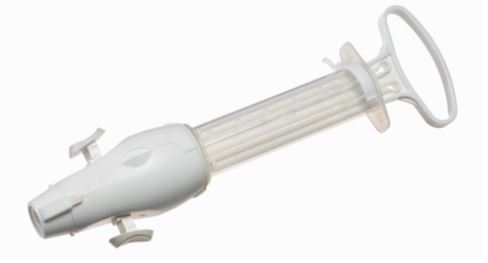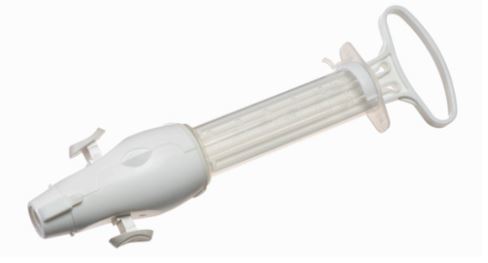ASPIRATION DEVICE, MVA PLUS (Ipas), 60 ml, autoclavable
STD
SCTDMVAS60A
Valid Article
Account code:
60210
HS Code:
903300
Last Updated on:
17/01/2025, 22:08:10
Former
Code(s):
-X
In Europe, medical material that fulfills the definition of a medical device according to the MDR (Medical Device Regulation) is classified into 4 classes
Thermosensitive codes are defined for storage and transportation temperature requirements of the products.
The product is part of at least one Kit.
A kit is a collection of products (medical and/or logistic) that are needed for a certain intervention in emergency. The choice and quantity of the articles reflects the MSF protocols for this specific situation. The use of Kits allows to start an intervention without a detailed evaluation.
ASPIRATION DEVICE, MVA PLUS (Ipas)
Definition
Manual vacuum suction system for uterine evacuation used for incomplete abortions and abortions up to maximum 12 weeks of amenorrhoea (since the last period).
Can be used in an outpatients' room under local anaesthesia.
Specifications
Some restricted information has been hidden. Sign in
to see this information
Technical specifications
- BARREL:
- transparent polypropylene (PP)
- cylindrical
- graduated in ml and in ounce (oz.)
- water-repellent graduations every ml and every ¼ of ounce
- capacity: 60 cc/ml
- diameter: 2.5 cm
- vacuum capacity: 60 to 66 cm Hg
- COLLAR STOP:
- polypropylene (PP)
- flexible half ring located on the top of the barrel
- ended by 2 small rods which protrude into the barrel and prevent the plunger from dislodging
- to remove the plunger, the collar stop has to be taken off
- PLUNGER:
- polypropylene (PP)
- length: 17.5 cm
- device to maintain vacuum (when the suction is complete, 2 lateral parts attached to the top of the central part prevent the plunger from retracting)
- DOUBLE LOCKING VALVE:
- polypropylene (PP)
- 2 valve buttons made of polyetherimide
- cap to fit the cannula
- removable valve liner
- allows a vacuum to be generated in the syringe before the procedure (vacuum is held as long as this valve is closed)
- Supplied with a silicone tube for lubrication and 1 nitrile rubber O-ring
- Compatible with EasyGrip® cannulae
- Non sterile device, autoclavable
Packaging & Labelling
Unit packaging: plastic bag.
To be Ordered Separately
- Easygrip cannula's of different sizes
- SCTDMVAS1--: SET OF SPARE ACCESSORIES: the set includes 1 of each of the following non-sterile articles:
- plunger O-ring
- collar stop
- cap
- 2 ml tube of silicone
Instructions for use
Some restricted information has been hidden. Sign in
to see this information
Maintenance
Read carefully the IFU from the manufacturer.
Disassemble the aspiration device before cleaning
Steam autoclave wrapped in a double layer of paper for 30 minutes at 121ºC with a pressure of 106 kPa.
Before use, reassemble, lubricate and check vacuum capability. The aspirator should be discarded and replaced for any of the following reasons:
- The cylinder is brittle or cracked or mineral deposits inhibit plunger movement.
- The valve parts are cracked, bent or broken.
- The buttons are broken.
- The plunger arms do not lock.
- The aspirator no longer holds a vacuum.
Storage
- Store between 15 and 30°C
- Protect from sunlight ‐ Protect from humidity
MSF requirements
Some restricted information has been hidden. Sign in
to see this information






![[KSURBMVA13S] MANUAL VACUUM ASPIRATION SET autocl. syr., 8 instr. + 5 dil.](/web/image/product.template/570399/image_256/%5BKSURBMVA13S%5D%20MANUAL%20VACUUM%20ASPIRATION%20SET%20autocl.%20syr.%2C%208%20instr.%20%2B%205%20dil.?unique=5633bde)
![[SCTDMVAC04A] (aspiration dev. MVA Plus) CANNULA EasyGRIP, Ø 4 mm](/web/image/product.template/572244/image_256/%5BSCTDMVAC04A%5D%20%28aspiration%20dev.%20MVA%20Plus%29%20CANNULA%20EasyGRIP%2C%20%C3%98%204%20mm?unique=c3dabdf)
![[SCTDMVAC05A] (aspiration dev. MVA Plus) CANNULA EasyGRIP, Ø 5 mm](/web/image/product.template/572246/image_256/%5BSCTDMVAC05A%5D%20%28aspiration%20dev.%20MVA%20Plus%29%20CANNULA%20EasyGRIP%2C%20%C3%98%205%20mm?unique=3a44a8e)
![[SCTDMVAC06A] (aspiration dev. MVA Plus) CANNULA EasyGRIP, Ø 6 mm](/web/image/product.template/572239/image_256/%5BSCTDMVAC06A%5D%20%28aspiration%20dev.%20MVA%20Plus%29%20CANNULA%20EasyGRIP%2C%20%C3%98%206%20mm?unique=3a44a8e)
![[SCTDMVAC07A] (aspiration dev. MVA Plus) CANNULA EasyGRIP, Ø 7 mm](/web/image/product.template/572240/image_256/%5BSCTDMVAC07A%5D%20%28aspiration%20dev.%20MVA%20Plus%29%20CANNULA%20EasyGRIP%2C%20%C3%98%207%20mm?unique=c8c74d9)
![[SCTDMVAC08A] (aspiration dev. MVA Plus) CANNULA EasyGRIP, Ø 8 mm](/web/image/product.template/572241/image_256/%5BSCTDMVAC08A%5D%20%28aspiration%20dev.%20MVA%20Plus%29%20CANNULA%20EasyGRIP%2C%20%C3%98%208%20mm?unique=f79ade9)
![[SCTDMVAC09A] (aspiration dev. MVA Plus) CANNULA EasyGRIP, Ø 9 mm](/web/image/product.template/572242/image_256/%5BSCTDMVAC09A%5D%20%28aspiration%20dev.%20MVA%20Plus%29%20CANNULA%20EasyGRIP%2C%20%C3%98%209%20mm?unique=3a44a8e)
![[SCTDMVAC10A] (aspiration dev. MVA Plus) CANNULA EasyGRIP, Ø 10mm](/web/image/product.template/572260/image_256/%5BSCTDMVAC10A%5D%20%28aspiration%20dev.%20MVA%20Plus%29%20CANNULA%20EasyGRIP%2C%20%C3%98%2010mm?unique=3a44a8e)
![[SCTDMVAC12A] (aspiration dev. MVA Plus) CANNULA EasyGRIP, Ø 12mm](/web/image/product.template/572265/image_256/%5BSCTDMVAC12A%5D%20%28aspiration%20dev.%20MVA%20Plus%29%20CANNULA%20EasyGRIP%2C%20%C3%98%2012mm?unique=90e3a98)
![[SCTDMVAS1--] (aspiration dev. MVA Plus) SET OF SPARE ACCESSORIES](/web/image/product.template/572263/image_256/%5BSCTDMVAS1--%5D%20%28aspiration%20dev.%20MVA%20Plus%29%20SET%20OF%20SPARE%20ACCESSORIES?unique=c3dabdf)